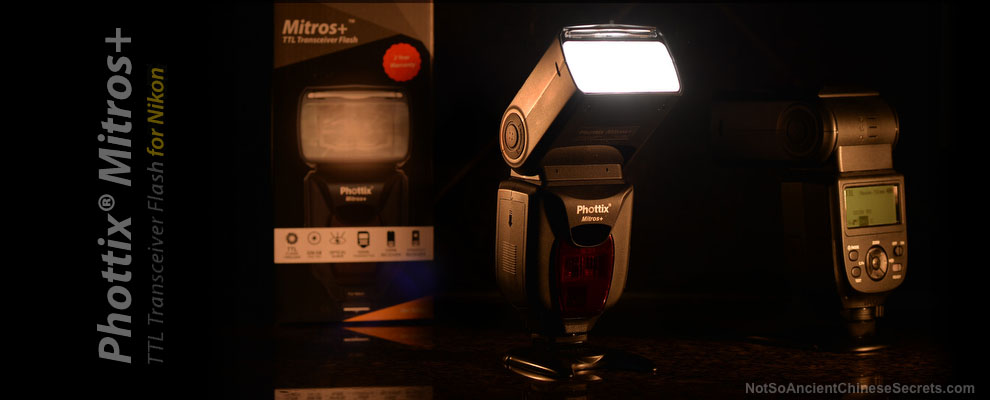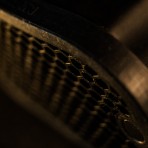
UPDATED 140817: Even sadder: FIVE out of six Mitros+ flashes for Nikon have now failed me 🙁 I can no longer recommend purchasing them at this time until they fix what seems to be a quality build issue. As an interim replacement, I’m using (and can recommend) the Phottix Odin TCU and Receiver kit. Along with our Nikon SB900’s they’ve been very reliable and don’t exhibit the unexpected non-linear manual-power performance of the Mitros+ flash. I’m not giving up on the Mitros+ and am hopeful they’ll be able to deliver a perfectly working and reliable system soon. But in their current state, there are obvious fixes to be made.
UPDATED 140708: Sadly a second of four flashes failed at our last wedding 🙁 It only flashes once every 3-5 exposures. Phottix service has been great at sending replacements, but I’d rather not use their 2-year warranty and just have reliable flashes to use. Updated recommendation for Nikon Mitros+ users: Still have issues with remote manual power control and reliability, but we’re personally still using this system – love the simplicity and lightweight system and when it works, it’s wonderful. Hoping they fix the kinks and we can wholeheartedly recommend soon.
UPDATED 140620: Recommendation for Nikon Mitros+ users to NOT update to firmware 1.05. Thanks to photographer friend Mark Romine who bravely did so but found the manual power control further reduced. Check out his comment below for the full story.
UPDATED 140603: Phottix *just* released firmware update 1.05 for the Mitros+ flash for Nikon. Several fixes are stated including tweaking of manual power settings, so here’s hoping. You can download the Mitros+ firmware update here.
UPDATED 140526: Revised Recommendation = HOLD for both TTL and manual shooters. One of four flashes failed at first wedding. Working to get a replacement from Phottix. Also confirmed that an on-camera Odin TCU (used as master) cannot get slave Mitros+ flashes to minimum manual power level of 1/128 – With Odin TCU set to 1/128 the slave gives several stops more light than when the slave Mitros+ is force set to manual power of 1/128. Still hoping forthcoming firmware updates and help from Phottix can make this system work as expected, but with the issues I’ve encountered I cannot recommend to purchase at this time.
UPDATED 140507: Shot our first wedding last weekend with 4x Phottix Mitros+ as OdinRX remotes triggered via 4x on-camera Odin TCU’s. Mostly good, but half-way through the day one flash just stopped flashing. It wasn’t worked that hard and was still operational as a radio trigger in Odin TX mode, but no flash would emit. Also found the 1/128 minimum manual power setting waaaaaay more powerful than it should be. Will need to test in detail, but looks like manual settings aren’t behaving linearly. Hoping a firmware update will fix.
UPDATED 140330: Revised Recommendation = BEST for manual flash shooters; HOLD for TTL shooters: Facebook Friends are finding issues with the Mitros+ when shooting in TTL mode. Reports include unacceptable recycle times, reduced power when bouncing the flash and other strangeness. As we shoot with 99% manual flash, we haven’t noticed these issues. I hope Phottix makes a priority of addressing these TTL issues as it’s not an isolated incident, but seemingly the majority which is seeing problems.
UPDATED 140306: Thanks to the great input of commenters on this article, I’ve updated the Pros Cons and Quirks section. Be sure to read the comments for real-world reports on reliability.
UPDATED 140311: Tested Mitros+ flashes with external battery packs and added comments in Pros and Cons section.
As professional photographers, it’s no secret that Quin and I love to literally light up our imagery. Mastering off-camera flash photography was a goal we made for ourselves over a decade ago and we continue to push towards the Light every shoot we do.
After testing (and being burned by) many off-camera flash systems, I try not to get too excited about new product announcements. But as a lighting Geek always on the lookout for the best, I was intrigued to hear about the release of the Phottix Mitros+ flash.
Note: we’re Nikon shooters, but Phottix has Canon-compatible kits too. This means much of this review is valid for Canon and Nikon shooters alike. WOOHOO!
What’s the big deal?
Nikon shooters like me have been patiently waiting for Nikon to catch up with Canon’s radio-controlled flash system. In a strange twist, Phottix has beat Nikon to the punch and, at least on paper, seemingly done Nikon flash better than Nikon.
There have already been innovative companies that add radio control to Nikon’s current flash offerings. But these involve the addition of a bulky radio unit via the hot shoe or optical port. Yet another piece of the puzzle adds an unwelcome layer of complexity to setup, battery management, and another link – the weakest of which may break the whole system.
The Phottix Mitros+ flash does everything Nikon’s flagship flash does PLUS adds radio triggering, remote zoom control and includes memory functions. Sounding too good to be true, I purchased an entire kit (actually, four) to test for myself.

Breakfast and Phottix Light Testing
What Makes for the Best Off-Camera Flash Photography System?
There are several “Must-have” features of any flash system we’ll consider using. These include:
- Reliability. As a professional photographer this is a must. Sadly, many flash systems don’t live up to their own hype and fail to pass this test.
- Shoot-position control. Not satisfied with simple dumb-flash-triggers; I want control at our fingertips.
- Travel-worthy robustness. We’re not just studio shooters so it has to pack light and take the abuse of real-world DQ full-contact wedding photography.
Unique Requirements for Multiple-Shooters
Note: You can skip this admittedly extra-geeky section if you never plan to shoot or share your lights with other photographers.
As a husband-wife shooting team who loves to light, our requirements for off-camera flash are a bit more complicated than those of single shooters. The problem is our desire to simultaneously shoot and trigger the same flashes at different mode and power settings. This allows Quin and me to shoot independently while still taking advantage of each other’s flashes.
Said another way, any remote flash system we use must send all mode (off, TTL or manual) and power level settings (exposure compensation or manual power setting) at time of shutter release.
This seems like a simple point, but many currently available systems send power level changes at the time the change is made. This means, “She who twiddles the knob last wins.” Cool if you have one main photographer and other second-shooters who want to mooch the same power settings. Not cool when you have two equal shooters who want full control of each light.
Yes: Quin and I are both flash control freaks.
Phottix Mitros+ Flash Review
Instead of re-hashing great website like this one that cover the Phottix flash system’s feature set, we’ll try to give a more hands-on look at the Mitros+.
Video 1: Hardware Comparison of the Mitros+, Nikon and Canon flashes
Impressive hardware is one thing, but how easy is it to program and access the various radio modes and power setings?
Video 2: Hands-on with the Mitros+ modes and menu system
Though I had to crack the PDF manual open, the menu system is well thought-out and the UI allows relatively quick changes of radio modes and settings.
Video 3: DQ recommended Mitros+ Custom Functions
How we set up our Mitros+ flashes for stealthy, speedy real-world wedding shooting.
Pros and Cons and Quirks
Pros:
- Smallest self-contained flash + radio remote package.
- Takes ubiquitous AA batteries (versus managing CR123’s, AA, AAA, esoteric button cells … etc.)
- Expandable: easily add studio strobes via Atlas II and Stratos II “dumb-triggers”
- Backwards compatible: for current Nikon/Canon (additional hardware required) and Phottix Odin users
- Firmware upgradable: includes USB cable for user-upgradability
- Less expensive than comparable (and less feature-laden) Nikon and Canon flashes
Cons:
- Pre-flash fires even when in Odin RX mode set to manual power. This adds unnecessary battery drain and annoyance (firmware upgrade fixable?)
- Inaccurate battery meter. Recycle time may slow even if battery indicator shows full.
- Slightly less powerful than Nikon and Canon flagship flashes
- Proprietary external power port requires (included) Nikon adapter. (Would prefer native Nikon power port)
- Fuji X100S (and presumably other non-Nikon cameras) cannot trigger Odin/Mitros+ for Nikon system (Wishlist: allow any standard hot shoe to trigger and control remotes in manual mode).
Quirks and Unknowns:
- Bug: when atop our Nikon Df in Odin TX mode at max FP sync shutter speed (1/250), bottom 5th of frame is not exposed (firmware upgrade fixable?)
- Buttons repeatedly “Beep” when pressed and held even with CF set to silence buttons (firmware upgrade fixable?)
- Unknown real-world reliability and robustness: 2 year warranty gives peace of mind, but DJ radio interference, reliability and abuse-proof yet to be tested
Conclusion
It’s hard not to be impressed with what Phottix has managed to cram into the Mitros+ flash. As an expandable system, it becomes even more appealing, offering the most elegant solution for off-camera flash shooters to date.
My nitpicks are minor and I’m hopeful most can be fixed via firmware updates. If the Mitros+ survives our shooting season, it will truly earn the crown of King of off-camera flash. For now, it’s a hearty recommendation with the only reservations being how battery life/recycle time, radio reliability and robustness play out in the real-world.

Thanks for reading and if you’re planning to make a purchase, would love your support by using the links below. Happy shopping and shooting!
Recommended radio flash kit for Nikon shooters*:
- Phottix Mitros+ radio flash for Nikon: on or off-camera Nikon-compatible flash with shoot-position radio control
- QuiKlips belt clips
- Phottix Odin radio flash kit for Nikon: adds shoot-position radio control to your Nikon flashes (includes SB700, SB800, SB900, SB910)
- Phottix Atlas ii long-range radio Transceivers: for triggering non-Nikon monolights and studio lights***
*Click here and scroll to the bottom for a list of compatible Nikon flashes and cameras.
B&H Links for Nikon shooters: Mitros+ flash, Odin radio kit, Complete Mitros+ and Odin starter kit
Recommended radio flash kit for Canon shooters**:
- Phottix Mitros+ radio flash for Canon: on or off-camera Canon-compatible flash with shoot-position radio control
- QuiKlips belt clips
- Phottix Odin radio flash kit for Canon: adds shoot-position radio control to your compatible Canon flashes
- Phottix Atlas ii long-range radio Transceivers: for triggering non-Canon monolights and studio lights***
**Not compatible with Canon’s own radio flash system; recommend this over Canon’s for lower price, better feature set and ease of expansion. Click here and scroll to the bottom for a list of compatible Canon flashes and cameras.
B&H Links for Canon shooters: Mitros+ flash, Odin radio kit, Complete Mitros+ and Odin starter kit
***Why do we choose the Atlas ii Transceivers over the Stratos ii Receivers as our Mitros+ compatible studio trigger? Both will work great, but for us a pair of Atlas ii’s have the advantage of (a) much farther range (we’ve shoot across mountaintops and this would have be soooo useful) and (b) standardizing on AA batteries. For super-long shots, a pair of Atlas ii’s will get the job done, and anything for simplifying battery/gear management is welcome.












